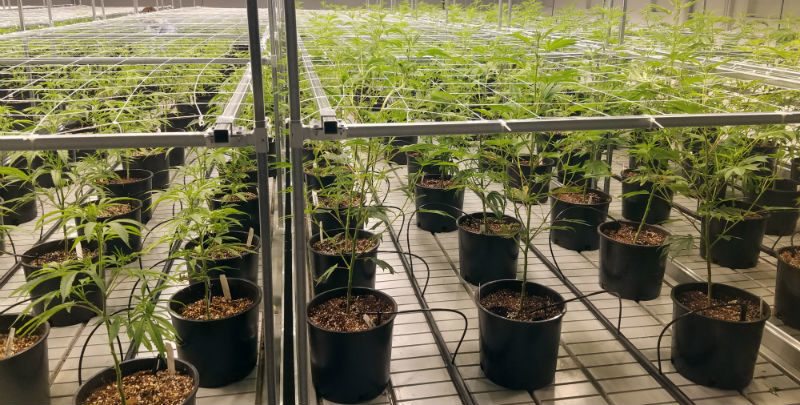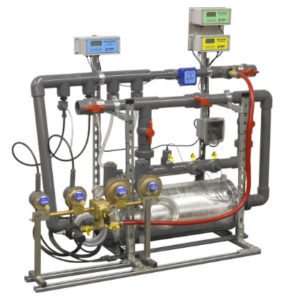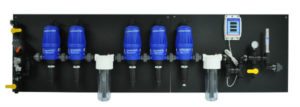
Managing Crop Fertility with Proven Horticultural Practices
With rapidly expanding state legalization of marijuana programs across the U.S., cannabis is entering an age of large-scale, commercial production. Even the most skilled legacy growers are discovering that it can be difficult and costly to scale old production methods to commercial levels. By turning to traditional horticulture, cannabis growers are learning about proven tools and practices that increase growing precision, improve operational efficiencies and decrease production costs.
Vegetable and ornamental growers study production costs and work to produce high-quality crops with tightly managed inputs and processes. Diligent use of automation and efficient use of consumables can greatly impact profit margins. The primary consumables used to produce crops include containers, media, nutrients and crop-protection products. Of these four categories, nutrients offer the greatest cost-reduction potential for large-scale, commercial cannabis growers.
Injection Systems
Several key opportunities for automation in cannabis production relate to nutrient delivery. First, consider how growers prepare nutrient solutions. It’s relatively common for cannabis growers to manually prepare ready-to-use nutrient solutions, often in volumes of 55 to several hundred gallons per batch. What if the time spent measuring and mixing nutrients was cut by 50 to 80 percent or more, and errors reduced? This is exactly what injectors enable!
Basic injector operation is the same regardless of brand and style. Injectors mix highly concentrated stock solutions with water at a specific ratio, such as 1:100 or 5 ml/gal. Injectors are plumbed in-line with the water supply, drawing stock on demand when crops are irrigated.
Several different types of injection systems are available, including water-driven and electrical systems. Lower ratio injectors, such as 1:100, are typically used to deliver fertilizers from infrequently prepared, long-lasting stock tanks. Higher ratio injectors, such as 1:750 (5 ml/gal), can be used to inject directly from packaged products. Sanitizers and crop supplements are commonly direct injected at high ratios.
It’s easy to understand how injector use can reduce labor costs and measuring errors. When direct injecting, the measuring step is eliminated. For fertilizer stock tanks, the volumes measured are typically larger and the frequency of measuring actions is greatly reduced. Larger volumes are easier to measure and allow for a larger margin for error.
Drip Irrigation

Another way to reduce labor is with a drip irrigation system. Drip systems automate crop irrigation with the added benefit of reducing overall water use. Irrigation lines run to each pot, terminating with rate-specific drippers. Properly regulated systems with pressure-compensated drippers deliver the same amount of nutrient solution to each pot on the line. In the same time it would take to water tens of pots by hand, hundreds of pots can be watered with drip systems. Frequency and duration of irrigation events are controlled manually or via automated controllers. Well-managed systems enable growers to maintain even moisture levels throughout the pot and avoid excessive water use.
What does a drip system cost? It’s surprisingly inexpensive, as little as $1.50 to $2.50 per pot for a system that can serve the facility for five to 10 years. When growers do the math, most quickly see a very rapid payback. More importantly, crops are more uniform and growers can turn attention to other activities.
Water-Soluble Fertilizers
Now that we know how to automate nutrient delivery to the crop, let’s turn to the nutrients themselves. Small- scale, conventional (non-organic) cannabis production has traditionally relied on bottled, liquid nutrients. While these products can be well formulated and are generally easy to use for small-scale production, they can be costly. The impact of the higher cost is relatively minor when growing a small number of plants in a market with minimal price pressures. However, the cost accounting model shifts under large-scale production when stronger competition and supply reduce retail and wholesale market pricing for cannabis products.
What does the world of traditional horticulture offer commercial cannabis growers as an alternative to bottled nutrients? We encourage commercial growers to switch to water-soluble fertilizers (WSFs). WSFs are powdered products built from naturally mined materials that have been processed for purity and other desirable factors, such as solubility and chelation. They are mixed on- site with water and delivered to the crop.

Cannabis growers commonly refer to WSFs as “salts.” While it’s true that these products are chemically classified as salts, it’s important to separate the chemical composition from the cultural results. Some growers associate “salts”
with harsh nutrients that can burn plants and assume that bottled nutrients are somehow softer and more forgiving. The reality is that most non-organic, bottled products are based on the same components as WSF: calcium nitrate, ammonium nitrate, potassium nitrate, magnesium sulfate and various micronutrients. Crop damage from high EC, or soluble salts, in the media occurs when crops are given an excessive amount of fertilizer, causing the fertilizer to accumulate in the media, or when fertilizer is applied to dry media. Either situation can happen with WSF or bottled nutrients.
WSFs afford tremendous control in the nutrient program. Different products can be blended together to provide the exact ratios of nutrients desired. For example, it’s easy to reduce the calcium applied to a crop if the irrigation water provides significant calcium. Using WSFs, this change can be made without altering the amount of nitrogen delivered to the crop. It’s also easy to choose formulations to balance the pH of the media and prevent high pH-induced deficiencies. If a specific nutrient deficiency does manifest in a crop, WSFs allow for corrective application of a single nutrient.
Horticultural WSFs use highly effective chelating agents to improve uptake of micronutrients. These chelating agents protect micronutrients from oxidation. Oxidation changes the form of the micros, which are nearly all metals, making them unavailable to the plant. The classic case of oxidation preventing nutrient uptake is high pH-induced iron deficiency. The best chelators will protect iron from the chemical effects of high pH, leaving the iron in solution for plant uptake.
Speaking of fertility, it’s worth noting that cannabis is a moderate feeder, not a heavy feeder as some believe. A constant feed rate of 100-ppm nitrogen will serve nearly all strains early in the vegetative phase. Later in vegetation, raise rates to 150-ppm nitrogen. As plant demands continue to increase, 200-ppm nitrogen will generally meet the crop needs at peak flower. From there, rates can be lowered back to 150-ppm nitrogen for a few weeks prior to pre-harvest treatments.
Just how much money can be saved by switching to WSFs? Mixing 100 gallons of a 200-ppm nitrogen solution using formulated WSFs should cost less than $1.75. After adding a few common supplements (silica, humic acid and amino acids), the per-100-gallon cost of a WSF-based program will still be less than $3.30. The cost of a nutrient program based on bottled products can vary greatly. Some quick math will show the savings. Simply work the math from your heaviest feed week in flower to determine your per-gallon cost in use. Then, multiply by 100 and compare this value with $3.30.
By adopting just a few practices and tools from commercial horticulture, cannabis growers can realize tremendous gains in their nutrient programs. These tools are robust, dependable and entirely proven in greenhouse production. The risk is minimal for adoption, and the reward is great.



